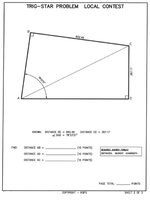You are using an out of date browser. It may not display this or other websites correctly.
You should upgrade or use an alternative browser.
You should upgrade or use an alternative browser.
Looking for help on finding distances (quadrilateral with two sides, three angles known)
- Thread starter jakebrax
- Start date
Dr.Peterson
Elite Member
- Joined
- Nov 12, 2017
- Messages
- 16,854
This is more than a "brushing-up" problem! I had to stare at it a bit before finding a likely approach.
Define angle BAC as x, and AC as d. Write two trig equations using these variables, based on triangles ABC and ADC. (When I tried this out, I didn't use actual numbers but let a=692.49, b=387.17, and A=78deg33min21sec. That let me do the work in general, without lots of long numbers.)
See what you can do to eliminate d and solve for x; from that, you should be able to find the three distances. Show us whatever work you do, and we can try to guide you along.
What contest is this from? [EDIT: I looked it up and found the problem in a sample test for a high school competition, https://cdn.ymaws.com/www.nsps.us.com/resource/resmgr/trig-star/18-19_sample.pdf.]
Define angle BAC as x, and AC as d. Write two trig equations using these variables, based on triangles ABC and ADC. (When I tried this out, I didn't use actual numbers but let a=692.49, b=387.17, and A=78deg33min21sec. That let me do the work in general, without lots of long numbers.)
See what you can do to eliminate d and solve for x; from that, you should be able to find the three distances. Show us whatever work you do, and we can try to guide you along.
What contest is this from? [EDIT: I looked it up and found the problem in a sample test for a high school competition, https://cdn.ymaws.com/www.nsps.us.com/resource/resmgr/trig-star/18-19_sample.pdf.]
Dr. Peterson thank you for the response, but I am still not getting it. Basically I need to setup two equations that solve for AC or d and since AC is the same for both then I can say that the equations are equal and solve for x correct? I just cant seem to figure out the appropriate equation.This is more than a "brushing-up" problem! I had to stare at it a bit before finding a likely approach.
Define angle BAC as x, and AC as d. Write two trig equations using these variables, based on triangles ABC and ADC. (When I tried this out, I didn't use actual numbers but let a=692.49, b=387.17, and A=78deg33min21sec. That let me do the work in general, without lots of long numbers.)
See what you can do to eliminate d and solve for x; from that, you should be able to find the three distances. Show us whatever work you do, and we can try to guide you along.
What contest is this from? [EDIT: I looked it up and found the problem in a sample test for a high school competition, https://cdn.ymaws.com/www.nsps.us.com/resource/resmgr/trig-star/18-19_sample.pdf.]
Dr.Peterson
Elite Member
- Joined
- Nov 12, 2017
- Messages
- 16,854
Please make an attempt, so I can see if you are close, or are misunderstanding my suggestion. It sounds like you have the right idea; once I see two equations, right or wrong, I'll be better able to guide you.
I was going to use the law of cosines but that seems like it has too many unknown variables so I thought. d=sinx/692.49 and d= 387.17/sin(78.56-x) so sinx/692.49=387.17/sin(78.56-x)Please make an attempt, so I can see if you are close, or are misunderstanding my suggestion. It sounds like you have the right idea; once I see two equations, right or wrong, I'll be better able to guide you.
Dr.Peterson
Elite Member
- Joined
- Nov 12, 2017
- Messages
- 16,854
That's very close to what I got; but why is the sin on top of one and in the bottom of the other?
Fix that, then use the angle-difference formula to express everything in terms of only sin and cos of x, then solve.
I had considered using the Law of Cosines, but it didn't look like it would go anywhere.
Fix that, then use the angle-difference formula to express everything in terms of only sin and cos of x, then solve.
I had considered using the Law of Cosines, but it didn't look like it would go anywhere.
Wow that problem became very annoying. so....That's very close to what I got; but why is the sin on top of one and in the bottom of the other?
Fix that, then use the angle-difference formula to express everything in terms of only sin and cos of x, then solve.
I had considered using the Law of Cosines, but it didn't look like it would go anywhere.
387.17/sin(78.56-x)=692.49/sin(x)
387.17sin(x)=692.49(sin(78.56)cos(x)-cos(78.56)sin(x))
and then reduce down from there?
Dr.Peterson
Elite Member
- Joined
- Nov 12, 2017
- Messages
- 16,854
That looks about right. Now collect terms in sin(x) on one side and cos(x) on the other, and you'll be able to find tan(x).

